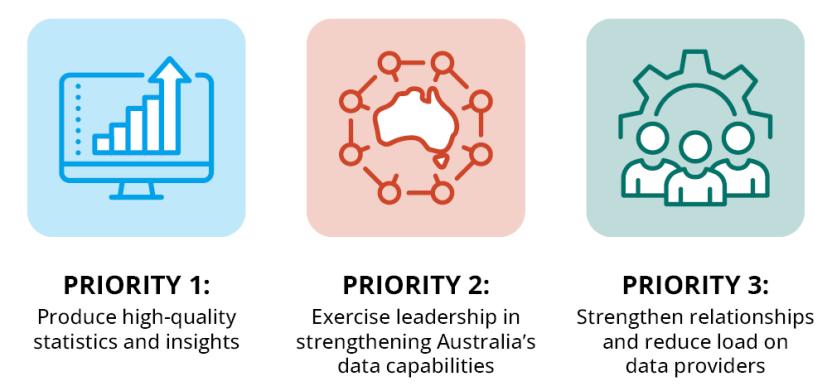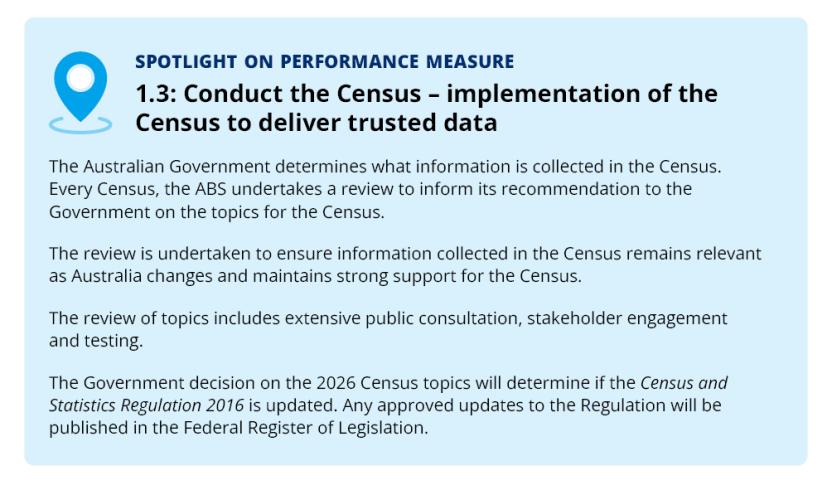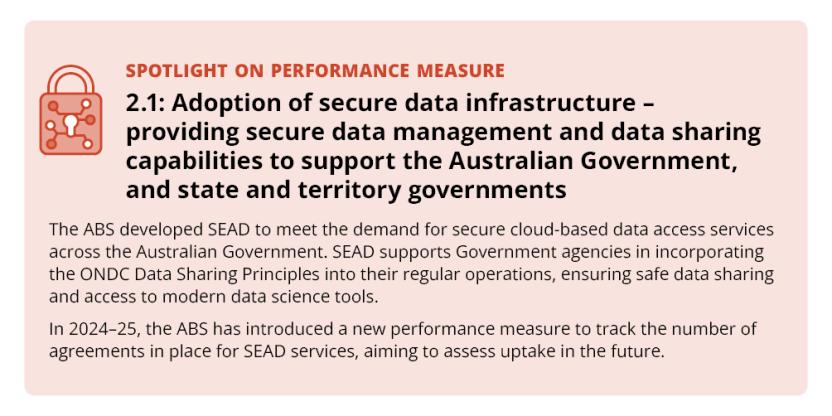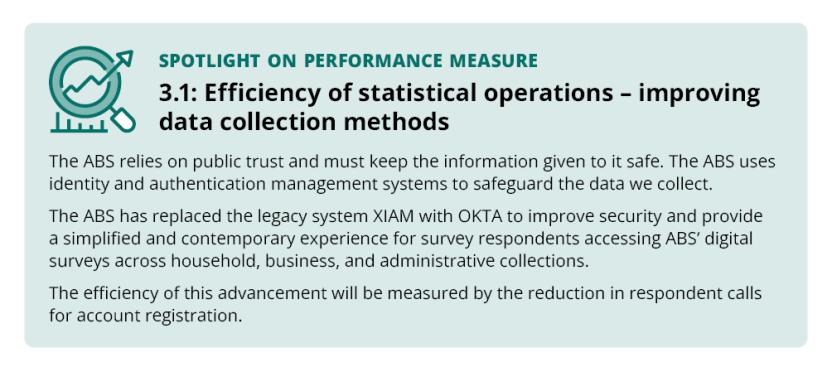- The Time Use Survey is released as How Australians Use Their Time.
- The Rise of Big Data and Integrated Data Assets – EY Conference ‘What not to ignore in ‘24’
https://www.abs.gov.au/about/our-organisation/australian-statistician/speeches/rise-big-data-and-integrated-data-assets
Activities
The Australian Statistician, assisted by the Executive Board, ensures planned and executed activities are coherent, complementary and coordinated by articulating the ABS’ strategic priorities. These strategic priorities are set through collaboration with our partners and stakeholders, and in response to the external operating environment.
The ABS’ strategic priorities are:
Image

These priorities provide clear alignment with the ABS’ Portfolio Budget Statements and internal planning document, the Enterprise Strategy 2024–25 to 2028–29.
The ABS has revised its strategic priorities in 2024–25 to improve clarity and highlight enhanced commitments to strengthening Australia’s data capabilities and the growing importance of the ABS’ relationships with both public and private sector data providers.
The ABS collects and analyses a broad range of social, economic, business, population and environmental data and produces valuable statistics and insights to inform Australia’s important decisions.
ABS data and statistics underpin fiscal and monetary policy and inform the delivery of programs and services vital to the health and wellbeing of Australians. They support a strong, well-functioning democracy and provide reliable information on a range of matters critical to public debate.
The ABS uses survey and administrative data to provide insights into Australia as a nation. The ABS continues to build relationships with all levels of government, academia, business and the not-for-profit sector to generate statistical information to inform and assess the effectiveness of economic, social and environmental policies. ABS consults key clients and users of ABS data and statistics to ensure innovative statistical products are relevant and valuable.
During 2024–25, the ABS will continue to deliver a range of economic, industry, environmental and agricultural statistics and products to meet the needs of government, businesses and the community.
Key activities include:
- producing high-quality, respected, well explained macroeconomic statistics, including the Australian System of National Accounts
- producing quality price indexes, including the Consumer Price Index (CPI) (quarterly and new monthly indicator), Producer Price Index and Wage Price Index
- developing new statistics from the BDTI project, including a complete monthly measure of the CPI due for release in 2025–26.
During 2024–25, the ABS will continue to deliver a range of population, labour and social statistics such as quarterly population estimates and the monthly labour force series to meet the needs of government, businesses and the community.
Key activities include:
- continuing to address labour market data gaps to enhance data on employment outcomes and barriers, modernise survey forms for labour market content, expand the Labour Account and consult with Aboriginal and Torres Strait Islander peoples on more frequent employment data
- enhancing industrial relations and regional labour market statistics and providing more detailed geographic breakdowns
- reinstating the General Social Survey to provide statistics annually from 2026 onwards for the Treasury’s Measuring What Matters framework
- reinstating the Time Use Survey¹ every 2 years to assist the understanding of how Australians balance their time between work, family, leisure and caring activities
- implementing an intercensal review of Net Interstate Migration to reduce the accumulation of errors in state and territory population estimates between Censuses.
As required by the Census and Statistics Act 1905, the ABS will conduct the next Census in 2026. The Census provides a snapshot of the economic, social and cultural make-up of the nation and tells the story of how Australia is changing over time. The design and development of the 2026 Census continues in 2024–25.
Key activities include:
- finalising 2026 Census content
- community engagement to co-design strategies and plans to support all people to participate in the Census
- delivering critical infrastructure to support a secure and trusted 2026 Census
ensuring the 2026 Census will be an easy and secure experience for all Australians.
Image

As the custodian of nationally significant data and statistical assets, the ABS serves a diverse range of stakeholders that use ABS data, including government agencies, local councils, the public, researchers, businesses and community groups. The ABS is dedicated to improving access to its products and services while maintaining privacy and confidentiality.
Key activities include:
- improving the digital experience for users by designing for accessibility and inclusiveness of ABS products and services using the Digital Service Standard 2.0 and Web Content Accessibility Guidelines 2.2.
The ABS builds and maintains integrated data assets for research in the public interest. By maintaining and regularly updating integrated data assets, the ABS can respond effectively to evolving research demands and users can undertake important research about people and businesses across time.
Key data asset activities in 2024–25 include:
- the Business Characteristics Asset is being rebuilt to provide tailored, granular and timely insights on Australian businesses
- developing new data assets to:
- support the Government’s Competition Review to provide greater ongoing visibility of merger and acquisition activity in the economy
- provide insights into gender-based violence through the Criminal Justice Data Asset
- create a new Early Childhood Education and Care cost index to track changes in the costs of delivering childcare services over time
- delivering the National Disability Data Asset (NDDA), a new source of information about people with disability. It will bring together de-identified data from Australian, state and territory government agencies for research and analysis. It will provide deeper, data driven insights about the needs and outcomes of people with disability to help improve programs and services
- continuing to develop the Life Course Data Initiative (LCDI), a 4-year program that will create a linked Life Course Dataset using Person-Level Integrated Data Asset (PLIDA) and deliver data insights to inform long term policy responses to address entrenched disadvantage.
The production of high-quality statistics relies on contemporary, high-quality statistical standards and infrastructure.
In 2024–25, the key activities include:
- completing the comprehensive review of the Australian and New Zealand Standard Classification of Occupations (ANZSCO). ANZSCO is used in the collection, publication and analysis of occupation statistics. It is used across the Australian Public Service (APS) in a variety of ways, including to reflect changes in the labour market. The review will be completed by December 2024 for use in the 2026 Census
- developing a coding capability using machine learning technology to code text to statistical classifications. This capability will be deployed as a whole of government facility for occupation coding, support ABS internal use across a number of classifications and increase data linkage and integration possibilities. This coding capability will also increase the efficiency of coding statistical information.
“Investment in the safe and secure linkage of administrative data is becoming increasingly important to provide the evidence base for policy, community-level insights, and program evaluation.
Over time, these data assets should greatly expand the opportunity for analysts, both within government and beyond, to do high-quality empirical research and evaluations of programs and thereby to improve the information base on which future public policy is formulated.”²
Dr David Gruen AO
The Australian Statistician serves as a member of the National Data Advisory Council (the Council), set up under the Data Availability and Transparency Act 2022. The Council provides advice to the National Data Commissioner on matters including ethical use of public sector data, balancing data availability with privacy protection, technical best practice, and industry and international developments.
Other ABS engagement across the APS includes:
- outposting a team to support the Office of the National Data Commissioner (ONDC) in its stewardship of data sharing legislation
- outposting staff to other Commonwealth entities to support the delivery of the Data and Digital Government Strategy
- contributing as a member of the Deputy Secretaries Data Group and Secretaries’ Data and Digital Committee to provide oversight of data initiatives
- driving the Data Champions Forum and supporting the ONDC to implement new data sharing legislation.
The APS Data Profession focuses on strengthening data capabilities within the APS workforce. Key initiatives include streamlined data graduate recruitment, developing data specialist capability, promoting diversity in data roles and providing data literacy education. In doing so, the APS aims to harness the increasing availability and value of data across teams and agencies.
As Head of the APS Data Profession, the Australian Statistician leads initiatives that attract, develop, and retain skilled data professionals, fostering innovation and collaboration across APS agencies. The Australian Statistician collaborates with agencies to champion the APS Data Profession strategy, ensuring its successful implementation and impact.
The Data Profession Members’ Community Platform (MCP) continues to grow. It connects data professionals across the Australian and state and territory public service and hosts communities of practice. As of 30 June 2024, the MCP has over 9,500 members across Australia, working to enhance the data capability of the public sector workforce for better national outcomes.
Key activities include:
- continuing to lead the APS-wide graduate recruitment for the Data Profession, recruiting on behalf of over 35 agencies in 2024–25
- promoting the data specialist employee value proposition to attract, recruit and retain data professionals at all levels
- leading the APS Data Awards, a celebration of outstanding data-driven initiatives across the APS
- maturing and delivering training modules targeting the Senior Executive Service and executive level cohorts, covering data governance, management and leadership
- refining and developing career pathway tools, capability frameworks and foundational training for graduates, data professionals and those seeking to uplift data literacy.
Government agencies use ABS investment and expertise to access secure cloud-based data services required to safely manage data sharing.
Key activities include:
- the ABS Secure Environment for Analysing Data (SEAD) service, which will continue to provide a series of secure, self-contained environments within the ABS DataLab’s cloud-based infrastructure. Government agencies using this service maintain full control and management of their data, users, projects and outputs in accordance with their legislative, policy and risk requirements. The ABS maintains the system's protections, in line with the Five Safes framework.
Image

The ABS continues to strengthen relationships with all levels of government, academia, business and the not-for-profit sector to generate statistical information to inform and assess the effectiveness of economic, social and environmental policies. The ABS consults key clients and users of ABS data and statistics to ensure innovative statistical products are relevant and valued.
The ABS’ Outposted Officer network facilitates access to statistics, develops statistical capability and aims to strengthen statistical coordination with federal, state and territory government host agencies. The ABS needs to remain agile and responsive to changing client needs and circumstances, while continuing to safeguard community trust in the ABS as an effective, secure and ethical organisation.
The ABS continues to modernise its data acquisition process to respond to long-term declines in survey response rates and improve methodology and systems to enable a digital-first approach to data collection from Australians.
The ABS is committed to reducing the burden on data providers and is continuously reviewing data collection methods to ensure information is being collected efficiently. In line with the Government’s Data and Digital Strategy, the ABS strives to collect information in the most efficient and timely way with as little cost as possible imposed on businesses and households.
The ABS is increasing its use of administrative data, including data collected by governments and businesses, to reduce the need to conduct surveys.
Key activities include:
- modernising the ABS’ agricultural statistics after ceasing large agricultural surveys. The ABS will instead use existing data from government, industry and commercial sources to produce official agricultural statistics, now known as the Australian Agriculture series
- modernising the ABS’ data sourcing capabilities and accelerating use of digital technologies through the Data Acquisition Modernisation Strategy. This work focuses on a digital first approach to encourage and support online participation and improve usability, accessibility, flexibility and security.
Image
